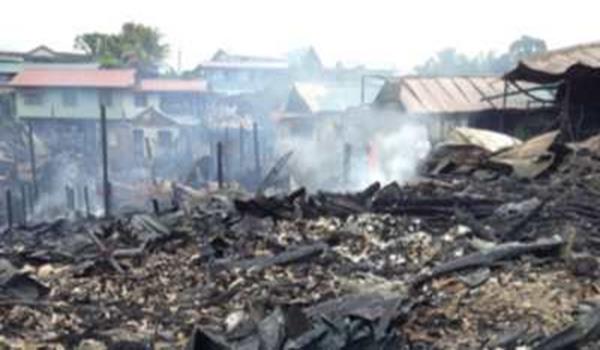The Kalaka under Penghulu Minggat and Chulo “Tarang”.
In June, 1843, after the Saribas Iban of the Padeh and Paku had been defeated by James Brooke and Captain Henry Keppel, Rimbas was similarly attacked and taken. Due to this many people from the Rimbas migrated to the Krian via the Melupa. Here they settled along the river up to the Babang tributary. When the Iban of the lower Batang Lupar, Saribas and Krian were beginning to enjoy peace after the defeat of Kedu “Lang Ngindang” at Mt. Stulak and that of Janting “Lang Labang” at Bukit Batu on the headwaters of Mujong, the Rajah decreed that all Iban who had settled along the Baleh and in its tributaries were to return and live under the control of the govern¬ment in the main Rajang below Kapit.
This intervention in Iban affairs was protested by a senior Iban leader of the Ulu Ai named Penghulu Ngumbang “Brauh Langit” of Mepi, who had fought against the government along the Kedang range in 1886. The Emperan, Katibas and the Rajang Iban assisted him, as did the warriors of Penghulu Bantin “Ijau Lelayang” of the Ulu Ai. The Rajah’s followers were led by OKP Nanang of the Padeh, Penghulu Minggat of Awik and Jabu of Bangat, Skrang. Two years after his defeat at Kedang, Penghulu Ngumbang, Penghulu Bantin, together with Imba and Allam, agreed to attend the peace-making ceremony to be held at both the Lubok Antu and Kapit forts.
Despite of the agreement to live in peace sworn at this peace-making, the Iban of Yong and Cheremin in the upper Rajang again grew restless and in 1894 openly revolted against the government. The Rajah led an expedition against them in person. He appointed the aged OKP Nanang of Padeh, Saribas, to lead the fighting. This was the last war that OKP Nanang took part in before his death in Padeh in 1901.
After peace was restored, Penghulu Bantin went from the Kampuas to Ulu Ai to buy jars. On his way home with a rusa-type jar he stayed one night in an Iban longhouse on the lower Batang Ai. Several days after he left the house, a man who lived there found a rusa jar missing. He reported the loss to Mr. Bailey, Resident of the Second Division in Simanggang. In his wrath against the Ulu Ai rebel chief, Mr. Bailey summoned Penghulu Bantin and accused him of having stolen the lost jar. Penghulu Bantin denied the charge, and therefore a bitter quarrel arose between Penghulu Bantin and the Resident.
Mr. Bailey demanded that Penghulu Bantin should pay the necessary jar tax. Penghulu Bantin refused to pay, since he had bought the jar with his own money. In this disagreement, Mr. Bailey lost his temper with Penghulu Bantin, who returned to the Ulu Ai and started to collect followers to rebel against the Sarawak Government. The Rajah, being misinformed by Mr. Bailey about the quarrel, led a punitive expedition against Penghulu Bantin from 1897 to 1904 which ended with the battle at Entimau hill in the upper Katibas. In the same year, 1904, Bantin’s followers, led by Kana of Engkari and Mantok “Batu Cheling” and the people of the Ulu Kanowit, were defeated by a government force under Munan Penghulu Dalam, at Wong Adai below the Meluan. This encounter was commonly called the Bongkap war since Mantok’s huge war boat was named Bongkap.
In 1906 Penghulu Ngumbang of the Mepi, Ulu Ai, supported by the Ulu Ai, Emperan, Kanowit, Julau, Katibas and Baleh Iban, renewed fighting against the government in the upper waters until defeated at Bukit Balong.
After these troubles had ended Penghulu Ngumbang and Penghulu Bantin agreed to make peace with the downriver Iban under Munan, and a peace-making ceremony was held at Kapit in 1907.
Munan, the Penghulu Dalam at Sibu, and Penghulu Ngumbang of Mepi in the Ulu Ai both died in 1914. In the following year the Baleh Iban led by Penghulu Merom rebelled against the government at Bukit Selong, at the source of the Mujong tributary and in the Gaat tributary. While fighting in the Gaat the government forces were headed by Gani “Sauh Besi”, the grandson of Kedu “Lang Ngindang” of the Skrang, who had settled at Bawang Assan near Sibu. The Gaat trouble ended in 1919 and there followed a peace-making ceremony at Kapit in 1920.
In the intervening year of 1916, the restless Iban of the Ulu Ai were led by one Tabor, a son of Penghulu Ngelingkong of the Mujan, to attack the Kayan of the upper Rajang. To stop this, the government sent a punitive expedition against them, and there was a battle at Nanga Pila, where Tabor was killed by a Constable named Impin “Pintu Batu Nanga Pila” of the Bangat, Skrang.
After the Iban troubles in the upper waters of the Batang Ai and Batang Rajang had stopped, a peace-making was held at Kapit between the Iban and the Kayan of Long Nawang (or Apo Kayan) in 1924. At this ceremony the Iban were represented by Penghulu Koh, Keling, Melintang and other upper Rajang and Baleh Penghulus. After the ceremony was over, and due to Penghulu Koh’s service in organizing the successful peace-making, Sir Charles Vyner Brooke, the third Rajah of Sarawak, promoted him to the rank of Temenggong.









Ba ni Bukit Balong nyak?
Qoute: In 1906 Penghulu Ngumbang of the Mepi, Ulu Ai, supported by the Ulu Ai, Emperan, Kanowit, Julau, Katibas and Baleh Iban, renewed fighting against the government in the upper waters until defeated at Bukit Balong.
Nama penyarut ti dikereja sida Iban ba Yong ngau Cheremin nyak?